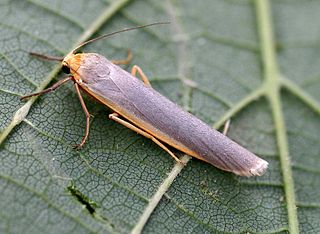Wittia is a genus of moths in the family Erebidae.

Brunia is a genus of tiger moths in the family Erebidae. The genus was erected by Frederic Moore in 1878.
Collita is a genus of moths in the family Erebidae. The genus was erected by Frederic Moore in 1878.
Dolgoma is a genus of moths in the family Erebidae. The genus was erected by Frederic Moore in 1878.

Eilema is a genus of moths in the subfamily Arctiinae. The genus was erected by Jacob Hübner in 1819.
Gandhara is a genus of moths in the subfamily Arctiinae. The genus was erected by Frederic Moore in 1878.

Manulea complana, the scarce footman, is a moth of the family Erebidae. The species was first described by Carl Linnaeus in his 1758 10th edition of Systema Naturae. It is found throughout the Palearctic region.

Wittia sororcula, the orange footman, is a moth of the family Erebidae. The species was first described by Johann Siegfried Hufnagel in 1766. It is found in Europe, Anatolia and further east across the Palearctic to southern Siberia and the Amur basin to China.
Katha is a genus of tiger moths in the family Erebidae. The genus was erected by Moore in 1878.
Prabhasa is a genus of moths in the family Erebidae.

Eilema lutarella is a species of moth in the family Erebidae. It is found in North Africa through Central Europe up to the area surrounding the Amur River and Sakhalin. In the north, it is found up to Scandinavia, Komi Republic in European Russia, Vitim river in Siberia.
Zobida is a genus of moths in the subfamily Arctiinae.
Zadadra is a genus of moths in the subfamily Arctiinae.

Manulea (Setema) cereola is a moth of the family Erebidae. It is found in Fennoscandia, the Baltic States, European Russia as well as the Alps and Urals. The species was first described by Jacob Hübner in 1803.
Muscula is a genus of moths in the family Erebidae.
Manulea costalis is a moth of the family Erebidae. It is found in Albania, Bulgaria, Serbia, North Macedonia, Greece and on Crete, as well as in Turkey and Armenia. on the Andamans and from India to Myanmar.
Prabhasa venosa is a moth of the family Erebidae. It is found in eastern India, Myanmar, Thailand, China and Taiwan.
Asiapistosia is a genus of moths in the subfamily Arctiinae.
Tarika is a monotypic moth genus of the subfamily Arctiinae in the family Erebidae. Its only species, Tarika varana, is found in Sikkim, India. The genus and species were both first described by Frederic Moore; the genus in 1878 and the species in 1866.
Eilema calamaria is a moth of the subfamily Arctiinae first described by Frederic Moore in 1878. It is found in the north-western Himalayas.





